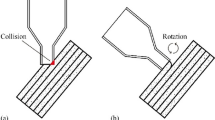Abstract
Robotics is intertwined with metrology, including aircraft component inspection, automotive processes, and part geometry optimization. Optimized trajectory planning is essential for reliable robotic arm operation and maintaining quality in inspections and geometric enhancements, as well as autonomous mobile robot navigation. Technically, a path planning is associated as an optimization problem that relies on various parameters such as length minimization problem, smooth trajectory planning, low time/space complexity, and computational load. While considering all these stated parameters, choosing an optimal path to reach the destination is the primary function of path planning techniques. This research paper is focused on the implementation of adaptive bidirectional A* (ABA*) algorithm along with new strategy of flexible controlling points technique (FCP) to reduce the trajectory error by generating smoother trajectory. With the increased number of sharp turns, the wheel skidding error is generated that reduce the reliability of the path planning techniques by increasing the pose estimation error. By conducting multiple trials, the proposed technique has been implemented, resulting in a 100% reduction in the number of collisions. Furthermore, the application of the new FCP technique eliminates all sharp turns, leading to a 38% decrease in time lag uncertainty compared to conventional approaches. The proposed technique improves autonomous navigation by selecting smoother trajectories.










Similar content being viewed by others
References
R. Siegwart, I.R. Nourbakhsh and D. Scaramuzza, Introduction to autonomous mobile robots. MIT Press (2011).
B. Siciliano and O. Khatib (eds), Springer handbook of robotics. Springer (2016), pp. 1577–1604.
R. Singh and K.S. Nagla, Improved 2D laser grid mapping by solving mirror reflection uncertainty in SLAM. Int. J. Intell. Unmanned Syst. (2018). https://doi.org/10.1108/IJIUS-01-2018-0003.
R. Singh and K.S. Nagla, Comparative analysis of range sensors for the robust autonomous navigation–a review. Sensor Rev., 40 (2019) 17–41. https://doi.org/10.1108/SR-01-2019-0029.
H.Y. Zhang, W.M. Lin and A.X. Chen, Path planning for the mobile robot: A review. Symmetry, 10 (2018) 450. https://doi.org/10.3390/sym10100450.
Z. Wu, G. Hu, L. Feng, J. Wu and S. Liu, Collision avoidance for mobile robots based on artificial potential field and obstacle envelope modelling. Assembly Autom., 36 (2016) 318–332. https://doi.org/10.1108/AA-01-2016-008.
P.E. Hart, N.J. Nilsson and B. Raphael, A formal basis for the heuristic determination of minimum cost paths. IEEE Trans. Syst. Sci. Cybernet., 4 (1968) 100–107. https://doi.org/10.1109/TSSC.1968.300136.
R.K. Singh and K.S. Nagla, Enhanced A* algorithm for the time efficient navigation of unmanned vehicle by reducing the uncertainty in path length optimization. MAPAN-J. Metrol. Soc India (2023). https://doi.org/10.1007/s12647-022-00618-6.
R.K. Singh and K.S. Nagla, A**: A bidirectional approach based on analytical treatment to conventional A* for the smooth and fast trajectory planning. Int. J. Inf. Tecnol. (2023). https://doi.org/10.1007/s41870-023-01269-9.
R. Singh, Trajectory optimization with hybrid probabilistic roadmap approach to achieve time efficient navigation of unmanned vehicles in unstructured environment. Robot. Intell. Autom. (2024). https://doi.org/10.1108/RIA-08-2023-0107.
R. Singh, Optimized trajectory planning for the time efficient navigation of mobile robot in constrained environment. Int. J. Mach. Learn. & Cyber., 14 (2023) 1079–1103. https://doi.org/10.1007/s13042-022-01684-7.
S. Kumar and A. Sikander, A novel hybrid framework for single and multi-robot path planning in a complex industrial environment. J. Intell. Manuf., 35 (2024) 587–612. https://doi.org/10.1007/s10845-022-02056-2.
B. Song, Z. Wang and L. Sheng, A new genetic algorithm approach to smooth path planning for mobile robots. Assembly Autom., 36 (2016) 138–145. https://doi.org/10.1108/AA-11-2015-094.
B. Fu, L. Chen, Y. Zhou, D. Zheng, Z. Wei, J. Dai and H. Pan, An improved A* algorithm for the industrial robot path planning with high success rate and shortlength. Robot. Autonom. Syst., 106 (2018) 26–37. https://doi.org/10.1016/j.robot.2018.04.007.
M. Davoodi, Bi-objective path planning using deterministic algorithms. Robot. Autonom. Syst., 93 (2017) 105–115. https://doi.org/10.1016/j.robot.2017.03.021.
J. Krishnan, U.P. Rajeev, J. Jayabalan and D.S. Sheela, Optimal motion planning based on path length minimisation. Robot. Autonom. Syst., 94 (2017) 245–263. https://doi.org/10.1016/j.robot.2017.04.014.
L. Zhang and Y. Li, Mobile robot path planning algorithm based on improved a star. J. Phys. Conf. Ser., 2021 (1848) 1–7. https://doi.org/10.1088/1742-6596/1848/1/012013.
N.H. Singh and K. Thongam, Mobile robot navigation using MLPBP approaches in dynamic environments. Arab. J. Sci. Eng. (2018). https://doi.org/10.1007/s13369-018-3267-2.
H.K. Paikray, P.K. Das and S. Panda, Optimal multi-robot path planning using particle swarm optimization algorithm improved bysine and cosine algorithms. Arab. J. Sci. Eng. (2021). https://doi.org/10.1007/s13369-020-05046-9.
B. Song, G. Tian and F. Zhou, A comparison study on path smoothing algorithms for laser robot navigated mobile robot path planning in intelligent space. J. Inf. Comput. Sci., 7 (2010) 2943–2950.
Author information
Authors and Affiliations
Corresponding author
Additional information
Publisher's Note
Springer Nature remains neutral with regard to jurisdictional claims in published maps and institutional affiliations.
Rights and permissions
Springer Nature or its licensor (e.g. a society or other partner) holds exclusive rights to this article under a publishing agreement with the author(s) or other rightsholder(s); author self-archiving of the accepted manuscript version of this article is solely governed by the terms of such publishing agreement and applicable law.
About this article
Cite this article
Singh, R.K., Nagla, K.S. Reduction in Trajectory Error by Generating Smoother Trajectory for the Time-Efficient Navigation of Mobile Robot. MAPAN (2024). https://doi.org/10.1007/s12647-024-00752-3
Received:
Accepted:
Published:
DOI: https://doi.org/10.1007/s12647-024-00752-3




